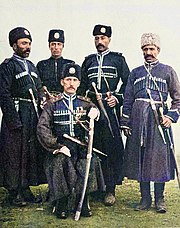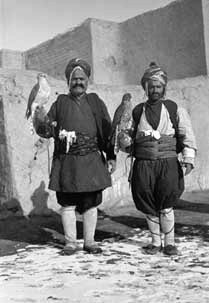User:LouisAragon/sandbox/Karapapakh
Karapapaklar | |
|---|---|
 Group of Qarapapaq Hamidiyeh Cavalry, Ottoman Empire (1901) | |
| Regions with significant populations | |
| Iran, Turkey, Georgia, Russia, Kazakhstan, Azerbaijan (Mostly western part and big cities such as Baku, Sumgait, Lankaran, Shirvan), Ukraine, Canada, United States of America, Armenia (USSR period), Uzbekistan, Germany, Belarus | |
| Languages | |
| Originally Karapapakh, nowadays mostly Azerbaijani, Turkish, Persian and Russian | |
| Religion | |
| Islam | |
| Related ethnic groups | |
| Azerbaijanis, Turkish people and other Turkic peoples |
The Karapapakhs (Azerbaijani: Qarapapaqlar; Turkish: Karapapaklar) are a Turkic people. Their original tongue, the Karapapakh language, is part of the western Oghuz branch and is closely related to Azerbaijani and Turkish. During the Soviet Union's existence, the Karapapakhs were culturally and linguistically assimilated by the Azerbaijanis and were already counted as "Azerbaijanis" in the 1959 and 1970 Soviet censuses. In 1944, they were subjected to mass deportations to Soviet Central Asia. Karapapakh is also no longer spoken in Turkey and has been completely replaced by Anatolian Turkish.
Name[edit]
Karapapakh translates as "black hat" in Oghuz Turkic.[1]
History[edit]
The Karapapakhs were originally a Turkoman group, being "Turkicized Kazakhs (Qazzaqs)".[1][2] They had moved into West Asia together with other Turkic-speaking and Mongol nomads, where some had become peasants.
Following the Russian victory in the War of 1826-1828 and the resulting Treaty of Turkmenchay, the Karapapakhs migrated from the area around the Debed river in eastern Georgia and along the Georgian-Armenian border to the Ottoman Empire and Qajar Iran.[3] They partly settled in the Ottoman region of Kars, where they formed 15% of the population, and partly in the Iranian region of Solduz (present-day Naqadeh), south of Lake Urmia.[3] Several years after the Russian conquest of Kars, the Tsarist government conducted a population counting of the newly acquired province.[3] In this 1883 population counting of the Kars Oblast, the Karapapakhs (in Russian, Карапапахи) numbered 21,652, of whom 11,721 were Sunnis and 9,931 were Shias.[3] According to the Russian Empire Census of 1897, the Karapapakhs numbered 29,879 in the entire Russian Empire.[3] Some years later, in 1910, according to Caucasus Calendar, they reportedly numbered 39,000 and were distributed in 99 villages in Kars Oblast.[3] 63 of these villages were located in the Kars district, 29 in Ardahan, and 7 in Kağızman.[3]
According to the 1926 Soviet census, the number of Karapapakhs had drastically declined to only 6,315, which reflected the loss of Kars Oblast to the newly established Republic of Turkey following World War I.[3] Mid-1920 figures reported that 70% of all Karapapakhs lived in Iran and 30% in the Soviet Union; the Karapapakhs in Turkey were most likely considered as Turks.[3]

According to Shirin Akiner's Islamic Peoples of the Soviet Union, first published in 1983 and dealing with the situation in and around the 1926 Soviet census, the great majority of the Karapapakh lived outside of the Soviet Union at the time.[4] Those within the Soviet Union, mainly lived in the southern part of the Azerbaijan SSR along the Aras River.[4] Akiner added that even in 1926, barely any Karapapakh was able to converse in the original Karapapakh language.[4] Most of the Soviet Karapapakhs at the time were Sunnis, with a minority being Shia.[4] The Karapapakhs were listed as a separate group in the 1926 Soviet census.[4] During the Soviet Union's existence, the Karapapakhs were culturally and linguistically assimilated by the Azerbaijanis, and they were counted as "Azerbaijanis" in the 1959 and 1970 Soviet censuses.[3]
In 1944, the Karapapakhs in the Soviet Union were deported en masse to Soviet Central Asia, along with Meskhetian Turks, Kurds and others of the Georgian SSR.[5][6]
According to Olson et al., which was published in 1994 and specifically deals with the ethnography of the Russian Empire and Soviet Union, the Karapapakhs are described as a small ethnic group and a Turkmen tribe, who primarily live in and around Tashkent, the capital of the Uzbek SSR at the time of the book's publication.[7] They add that they are primarily Shias, and, particularly, that of the Ali-Illahism syncretic religion, unlike most Muslims of the Soviet Union, "who are followers of the Sunni tradition".[7] They also explain that due to their religious practises, "there has traditionally been an element of secretiveness and fanaticism to Karapapakh religion".[7] Bennigsen likewise stated that "a certain number of the Karapapakhs are Ali Ilahis, which somewhat hinders their assimilation by the Azeris".[2]
Olson et al. lastly added that there were more than 10,000 Karapapakhs in the Soviet Union at the time, with most of them localized in Soviet Central Asia; small numbers of Karapapakhs had been able however to return to southern Georgia and northern Armenia in the 1980s.[8] Some 30,000 and 60,000 Karapapakhs were reportedly living in Iran and Turkey respectively at the time.[8] Groups of Karapapakh still live around Ardahan, Kars and Igdir to this present day.[9]
Language[edit]
The Karapapakhs originally mainly spoke their own western Oghuz language, which is part of the western Oghuz branch and is closely related to Azerbaijani and Anatolian Turkish.[3][a] In the Georgian SSR of the Soviet Union, this language was often confused with Azerbaijani.[3] Bearing similarties to the process of assimilation in the Soviet Union, in Turkey, the Karapapakhs no longer speak their own Turkic tongue, and have completely switched to Anatolian Turkish.[3][b] Brent Berndemoen notes in Turkic-Iranian Contact Areas: Historical and Linguistic Aspects that the migration of the Karapapakhs (and Terekeme, amongst others) in modern times from Turkey's east has been responsible for bringing Arabic loanwords with Persian vocalism to isolated areas as far west as Kangal in Sivas.[10]
Traditional economy[edit]
The Karapapkhs were traditionally involved in sheep-rearing and a bit of agriculture.[3]
See also[edit]
- Ayrums
- Qajar Iran#Migration of Caucasian Muslims
- Azerbaijanis in Turkey
- Iranian Azerbaijanis
- Meskhetian Turks
- Peoples of the Caucasus in Iran
References[edit]
- ^ a b Bournoutian 1992, p. 50.
- ^ a b Bennigsen & Wimbush 1986, p. 137.
- ^ a b c d e f g h i j k l m n o p Barthold & Wixman 1978, p. 627.
- ^ a b c d e Akiner 1983, p. 254.
- ^ Olson, Pappas & Pappas 1994, p. 346-347.
- ^ Wixman 1984, p. 95.
- ^ a b c Olson, Pappas & Pappas 1994, p. 346.
- ^ a b Olson, Pappas & Pappas 1994, p. 347.
- ^ a b Bournoutian 2017, p. 331 (note 28).
- ^ Brendemoen 2006, p. 231 (note 6).
Sources[edit]
- Akiner, Shirin (1983). Islamic Peoples Of The Soviet Un. Kegan Paul International.
- Barthold, W. & Wixman, R. (1978). "Ḳarapapak̲h̲". In van Donzel, E.; Lewis, B.; Pellat, Ch. & Bosworth, C. E. (eds.). The Encyclopaedia of Islam, Second Edition. Volume IV: Iran–Kha. Leiden: E. J. Brill. OCLC 758278456.
- Bennigsen, Alexandre; Wimbush, S. Enders (1986). Muslims of the Soviet Empire: A Guide. C Hurst & Co Publishers Ltd.
- Bournoutian, George (1992). The Khanate of Erevan Under Qajar Rule, 1795-1828. Mazda Publishers.
- Bournoutian, George (2017). "The Population of the South Caucasus according to the 1897 General Census of the Russian Empire". Iran and the Caucasus. 21 (3): 324–340. doi:10.1163/1573384X-20170307.
- Brendemoen, Brent (2006). Johanson, Lars; Bulut, Christiane (eds.). Turkic-Iranian Contact Areas: Historical and Linguistic Aspects. Harrassowitz Verlag.
- Olson, James Stuart; Pappas, Lee Brigance; Pappas, Nicholas Charles, eds. (1994). An Ethnohistorical Dictionary of the Russian and Soviet Empires. Greenwoon Press.
- Wixman, Ronald (1984). Peoples of the USSR: An Ethnographic Handbook. M.E. Sharpe.
Cite error: There are <ref group=lower-alpha> tags or {{efn}} templates on this page, but the references will not show without a {{reflist|group=lower-alpha}} template or {{notelist}} template (see the help page).
